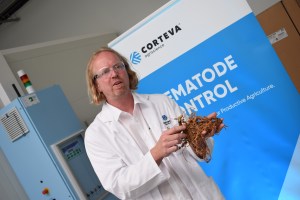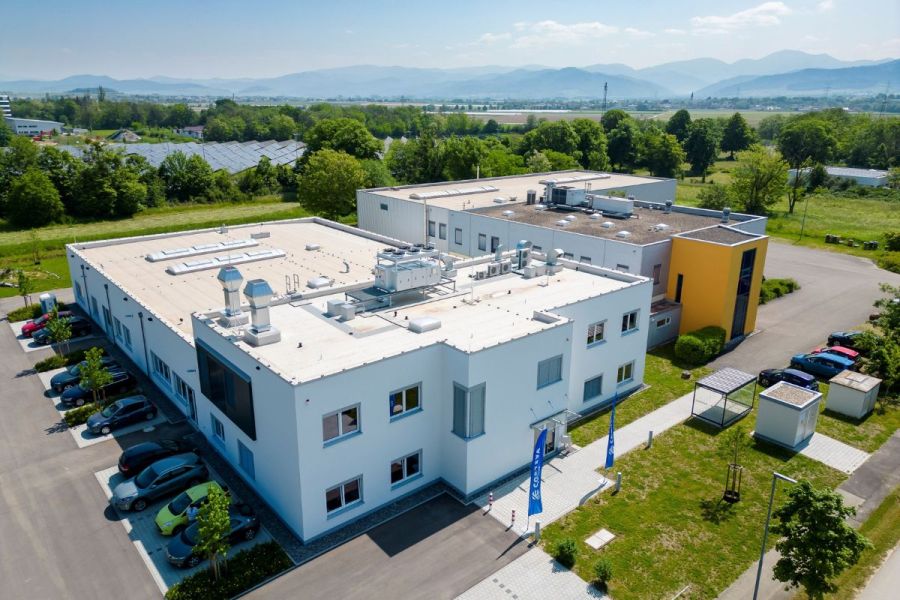Following the relaunch of Corteva’s R&D site in Germany, CPM headed over to learn what the company’s upcoming plans could mean for UK growers and beyond.
“There are so many reasons to turn to innovation, and in particular, biologicals, as a means of providing yield and quality to consumers.”
By Janine Adamson
Uniting plant breeding and crop protection research together under one roof is the promise of Corteva Agriscience’s revamped R&D facility in Eschbach, Germany. With €6M of investment, the company says it signifies a new dawn in its ability to deliver sustainable solutions to farmers worldwide.
Coined as Corteva’s first ‘integrated site’, Eschbach now focuses on three key functions – seed product development, molecular biology and genotyping, and crop protection discovery. And despite past history, the aim is to reduce use rates of conventional plant protection products through the development of biological innovations and naturally-derived active ingredients.

Tim Thoden has been working on a selective nematicide which can target pests such as the root-knot nematode.
“There are so many reasons to turn to innovation, and in particular, biologicals, as a means of providing yield and quality to consumers,” says Corteva’s category marketing manager, John Sellars. “Eschbach is playing a vital role in making the link from lab to the field, which is critical in scaling up such innovations.”
Thanks to the recent acquisition of microbiological specialist, Symborg, these new innovations include a promising insect control measure based on an entomopathogenic fungi, Beauveria bassiana strain 203.
Corteva first collaborated with Symborg to scale up BlueN nutrient efficiency optimiser in the UK but is now focusing on the role of Beauveria bassiana and its efficacy on a range of pests including wireworm.
“Fungi can be dependent on weather conditions, but Beauveria bassiana is very resilient even in high pressure scenarios,” says Global Biology Leader Biological Insect Control, Maria Torne.
“It works by penetrating the skin of susceptible insects, multiplying and then consuming the pest’s nutrients. The insect dies and the fungus emerges to the surface to produce further spores, dispersing it among the pest population.”
Although conventionally used to control red palm weevil (Rhynchophorus ferrugineus), it’s hoped Beauveria bassiana strain 203 will offer activity against a wide range of insect pests in the field and under glass. Part of Corteva’s development work is to also investigate combining it with bait traps to optimise application timings thereby improving its efficacy further.
As well as Symborg, Corteva has completed the acquisition of Stoller – one of the world’s largest independent biological companies. However, identifying unique modes of action isn’t new for the R&D team at Eschbach.
To illustrate, global nematology expert, Dr Tim Thoden, says his team’s work has shown it’s possible to target plant-parasitic nematodes without negatively affecting beneficial soil organisms.
“The Reklemel active (fluazaindolizine) is a first-of-its-kind – a selective nematicide which can target pests such as the root-knot nematode by interrupting their behaviour. It’s different to old-style nematicides in that it prioritises soil health with no negative impact on beneficial nematodes, fungi and such,” says Tim.
Present in in the UK, root-knot nematodes can infect a wide range of host crops including potato and sugar beet, and have even been identified in wheat. They can be particularly devastating in tomato plants, presenting as poor crop vigour and leaf wilting.
“Reklemel works differently than any other nematicides currently available, controlling harmful nematodes by affecting their ability to move and infect plant cells. New modes of action like this are important to help reduce the chance of nematodes developing resistance,” adds Tim.
Beauveria bassiana and the Reklemel active are just two examples of the work being undertaken at Eschbach to help address sustainability goals. And although such R&D work is classed as discovery, Corteva terms it as ‘filtering’ of active ingredients.

Corteva believes gene editing is an important tool and it’s the company’s social responsibility to make it available, says Frank Röber.
This careful selection process also applies to seed breeding, of which Eschbach has more than 20 years’ experience. Overseen by Dr Frank Röber, the team is working on a range of projects which utilise gene editing, of which the UK is ahead of the curve compared with its European counterparts.
“Corteva believes gene editing is an important tool and it’s our social responsibility to make it available,” says Frank. “We’re championing CRISPR-Cas9 [precise gene editing technology] as the future, however, we really require social acceptance for it all.”
Examples of projects being undertaken at the centre’s labs include reducing the rancidity of pearl millet flour, overcoming maize lethal necrosis disease for crops in Africa, and enabling efficient soybean production in Europe.
For the soybean work, Corteva is collaborating with the Institut National de la Recherche Agronomique (INRAE) to support PhD research student Marion Monfort. Together they hope to select plants which show an earlier flowering time phenotype and therefore reach maturity sooner.
The project is in its second phase of testing and depending on regulatory developments, should be available for commercialisation in around two years.
The team believes this work is significant because soybean can offer sustainable, local protein production while being an alternative break crop which benefits soil health. They’re also working on new high-protein feedstock varieties to reduce soybean imports into Europe.
Although the R&D focus at Eschbach is to filter and select for future innovations, the team also recognises the importance of protecting the lifecycle of existing products through using a ‘multidisciplinary approach’. This again applies the ethos of uniting plant breeding with crop protection R&D.
An example being PT303 hybrid oilseed rape – launched as the first sclerotinia-tolerant variety for UK growers. Understanding genetics can’t always provide full protection, research is taking place to optimise a programme which uses the variety alongside a biofungicide currently registered in France.
“Trials have shown synthetic fungicide use can be reduced by 50% when using the Protector Sclerotinia genetics found in PT303,” says Corteva’s Bernard Straebler.
“The aim is use biofungicides to maintain the integrity of those genetics while achieving a similar level of disease control as a conventional synthetic fungicide programme.”
Biological company acquisitions, championing gene editing, and developing their own new sustainable products – does this mean Corteva is turning away from traditional plant protection completely? Dr Andreas Huber, integrated field sciences leader, says that’s not quite the case.
“Corteva is committed to addressing the UN’s Sustainable Development Goals through identifying products that are naturally derived, degrade quickly, have low acute toxicity and can be used at reduced rates.
“A key part of this is lowering the grammes of active ingredient per hectare of new products, ideally to less than 10g ai/ha while maintaining control. We’re still developing conventional products, but all-round safety is a priority for our pipeline innovations,” he says.
To ensure the work at Eshbach is applied research which translates effectively to the field, on-farm trials are taking place at Bantzenheim in France, just 3km from the German border. This includes refining nitrogen usage and trialling a new product from its range – Utrisha Rhizo.
The biostimulant, developed in conjunction with STI Biotechnologie, is for vegetable crops including potatoes, and should be available in the UK from next year. John says Utrisha Rhizo is a unique combination of two probiotic bacteria that work by solubising micro and macro nutrients in the soil, helping to improve the rhizosphere and nutrient uptake in the plant.
“As a biostimulant, it enhances nutrient and water uptake through a larger rooting system. The result is an impressive uplift in both yield and quality for high value crops. For vegetables such as brassicas, the plant really benefits.”
In addition, the French field site is exploring the potential of the Rinskor active (florpyrauxifen-benzyl) in sugar beet, which is renowned for its very low use rate, around 2g ai/ha. Whereas technology is also playing an important role with drones, sensors and algorithms being used to automatically rank trial plots, count insect pests, rate diseases and identify weeds.
John explains excitement is high and the pace is fast for Corteva R&D particularly with respect to biological candidates, with acquisitions contributing to this considerably. “Applying our scientific scrutiny and leveraging our investments into facilities such as Eshbach means there’s a lot being prepared in readiness to launch over the next few years.
“But equally, we’re writing business cases for products which may not arrive for another 10 years,” he concludes.
This article was taken from the latest issue of CPM. Read the article in full here.
For more articles like this, subscribe here.
Sign up for Crop Production Magazine’s FREE e-newsletter here.




